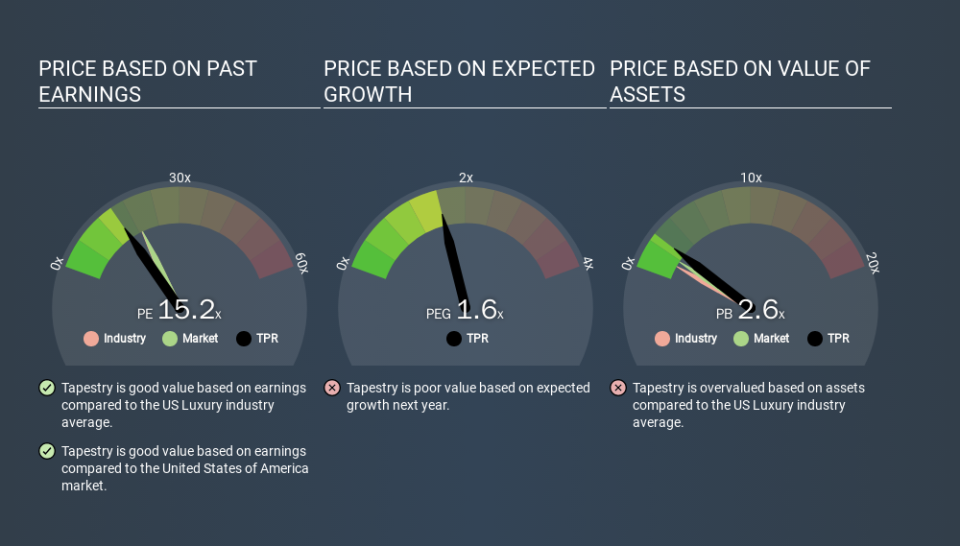Here's How P/E Ratios Can Help Us Understand Tapestry, Inc. (NYSE:TPR)

The goal of this article is to teach you how to use price to earnings ratios (P/E ratios). To keep it practical, we'll show how Tapestry, Inc.'s (NYSE:TPR) P/E ratio could help you assess the value on offer. What is Tapestry's P/E ratio? Well, based on the last twelve months it is 15.37. In other words, at today's prices, investors are paying $15.37 for every $1 in prior year profit.
See our latest analysis for Tapestry
How Do I Calculate A Price To Earnings Ratio?
The formula for price to earnings is:
Price to Earnings Ratio = Price per Share ÷ Earnings per Share (EPS)
Or for Tapestry:
P/E of 15.37 = USD28.85 ÷ USD1.88 (Based on the year to September 2019.)
Is A High P/E Ratio Good?
The higher the P/E ratio, the higher the price tag of a business, relative to its trailing earnings. That is not a good or a bad thing per se, but a high P/E does imply buyers are optimistic about the future.
How Does Tapestry's P/E Ratio Compare To Its Peers?
One good way to get a quick read on what market participants expect of a company is to look at its P/E ratio. If you look at the image below, you can see Tapestry has a lower P/E than the average (19.5) in the luxury industry classification.
Tapestry's P/E tells us that market participants think it will not fare as well as its peers in the same industry. Since the market seems unimpressed with Tapestry, it's quite possible it could surprise on the upside. You should delve deeper. I like to check if company insiders have been buying or selling.
How Growth Rates Impact P/E Ratios
Generally speaking the rate of earnings growth has a profound impact on a company's P/E multiple. Earnings growth means that in the future the 'E' will be higher. That means unless the share price increases, the P/E will reduce in a few years. So while a stock may look expensive based on past earnings, it could be cheap based on future earnings.
Tapestry's earnings per share were pretty steady over the last year. But over the longer term (3 years), earnings per share have increased by 2.7%. And over the longer term (5 years) earnings per share have decreased 5.4% annually. So we might expect a relatively low P/E.
Remember: P/E Ratios Don't Consider The Balance Sheet
It's important to note that the P/E ratio considers the market capitalization, not the enterprise value. In other words, it does not consider any debt or cash that the company may have on the balance sheet. Theoretically, a business can improve its earnings (and produce a lower P/E in the future) by investing in growth. That means taking on debt (or spending its cash).
Such spending might be good or bad, overall, but the key point here is that you need to look at debt to understand the P/E ratio in context.
How Does Tapestry's Debt Impact Its P/E Ratio?
Net debt totals 10% of Tapestry's market cap. This could bring some additional risk, and reduce the number of investment options for management; worth remembering if you compare its P/E to businesses without debt.
The Verdict On Tapestry's P/E Ratio
Tapestry has a P/E of 15.4. That's below the average in the US market, which is 19.1. EPS grew over the last twelve months, and debt levels are quite reasonable. If growth is sustainable over the long term, then the current P/E ratio may be a sign of good value.
When the market is wrong about a stock, it gives savvy investors an opportunity. As value investor Benjamin Graham famously said, 'In the short run, the market is a voting machine but in the long run, it is a weighing machine. So this free visual report on analyst forecasts could hold the key to an excellent investment decision.
Of course you might be able to find a better stock than Tapestry. So you may wish to see this free collection of other companies that have grown earnings strongly.
If you spot an error that warrants correction, please contact the editor at editorial-team@simplywallst.com. This article by Simply Wall St is general in nature. It does not constitute a recommendation to buy or sell any stock, and does not take account of your objectives, or your financial situation. Simply Wall St has no position in the stocks mentioned.
We aim to bring you long-term focused research analysis driven by fundamental data. Note that our analysis may not factor in the latest price-sensitive company announcements or qualitative material. Thank you for reading.

 Yahoo Finance
Yahoo Finance 
